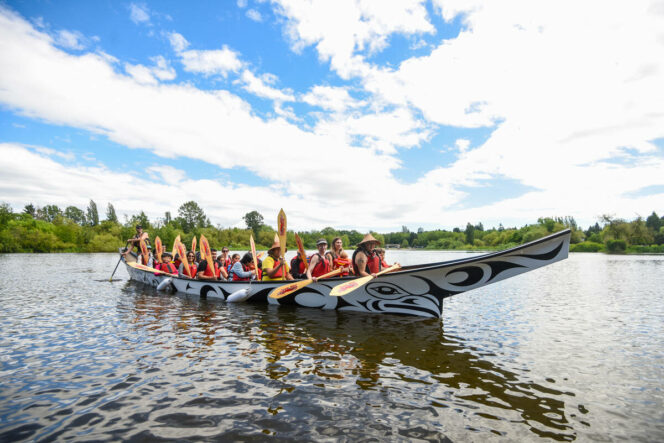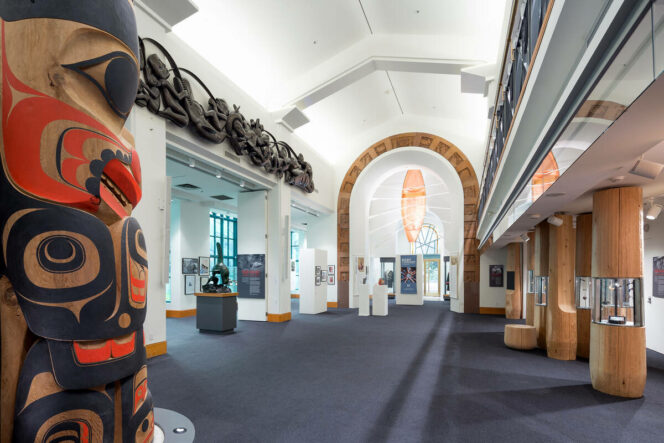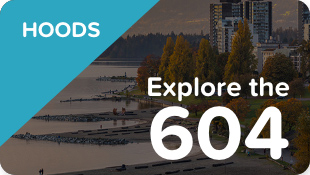
Musqueam Welcome Figures, 1996, Artist: Susan Point,
YVR Airport Terminal: International
Vancouver is located on the ancestral and unceded territory of the xʷməθkʷəy̓əm (Musqueam), Sḵwx̱wú7mesh (Squamish), and səlilwətaɬ (Tsleil-Waututh) Nations. The rich heritage and cultural vitality of these Nations play a key role within Vancouver, which was designated a City of Reconciliation on July 8, 2014, when the Council adopted a Reconciliation Framework. There are numerous ways throughout Vancouver to celebrate and honour Indigenous culture in the ongoing work of (re)education, respect, and sharing.
Indigenous Cultural Centres

Squamish Lil’wat Cultural Centre (courtesy Destination BC/Indigenous Tourism BC).
The Squamish Lil’wat Cultural Centre is a rich facility that showcases the cultures of two Nations whose traditional territories are located in present-day Whistler. The Centre is a place of learning and storytelling, with hourly guided tours, specialty tours (e.g., Interpretative Forest Tours), exhibits (e.g., 100 Years of Unity until October 8, 2023), as well as craft activities, workshops, and events.
The Musqueam Cultural Centre as well as other administrative buildings are located on the Musqueam Reserve, west of Southlands, along the Fraser River (this is only a small part of their traditional territory). While the Culture Centre and its Gallery are currently closed to the public, educational groups can request cultural walking tours of the Reserve and the Gallery. The Musqueam Indian Band is also involved in numerous cultural and artistic collaborations (see further information below in Art Found Throughout the City) and events that celebrate Indigenous culture, including Come Toward the Fire (see further information below in Festivals).
Indigenous-Led Tours

Paddlers in a First Nations Canoe. Photo: Destination Vancouver/Vision Event Photography Inc.
There are numerous companies in Vancouver that offer Indigenous-led tours, which take guests on a journey through history, a sense of place, and the interrelationships with the natural world. Takaya Tours, owned and operated by the Tsleil-Waututh Nation leads two tours: the first are Cultural Canoe Tours (April to October) where guests paddle through the Burrard Inlet and Indian Arm while listening to guides tell them stories and provide rich information about their surroundings. The second are split between canoeing and walking, discussing harvesting techniques in addition to storytelling and ecological education.
Talaysay Tours, founded and operated by Candace and Larry Campo, members of the Sechelt and Squamish Nations, are well known and respected for their tours. Their most popular one is Talking Trees, which takes places in Stanley Park and blends history, legends, medicinal knowledge, and ecological education. Other tours include Talking Totems, Forest Bathing, and Spoken Treasures.
The híwus Feasthouse on Grouse Mountain offers programming for groups (geared primarily for students but also suitable for adults). Typically, after riding the Skyride, groups will go on an interpretative eco-walk or snowshoe to the Feasthouse. There, they’ll partake in a First Nations Cultural Program, in which they’ll learn about Squamish culture, as well as legends and dance. Craftwork and lunch are included. There is also a First Nations Heart Program, which focuses on education about Residential Schools.
Museums and Galleries

Photo: Sama Jim Canzian/Bill Reid Gallery
Museums across the city offer exhibitions that explore important aspects of Indigenous cultures on the West Coast. The Museum of Vancouver (MOV) in Vanier Park currently features a Unity Indigenous Plant Garden: A Living Exhibition; c̓əsnaʔəm: The City Before the City; and That Which Sustains Us, which includes traditional ecological knowledge on forests.
Stay tuned for the reopening of the Museum of Anthropology at the end of 2023. The MOA features impressive collections from West Coast carvers and artists, which include house posts, feast dishes, sculptures, and textiles; as well as the largest collection of Bill Reid works. Their exhibitions are thoughtful, collaborating with Indigenous artists, elders, and curators to focus on particular cultural and artistic practices, such as weaving.
Capilano Suspension Bridge Park features Kia’palano, which is an educational centre for learning about the Sḵwx̱wú7mesh (Squamish), and səlilwətaɬ (Tsleil-Waututh) Nations on whose unceded territory the Park is located. Learn also the stories behind the totem poles located throughout the park.
Within the BC Sports Hall of Fame, you’ll find the Indigenous Sports Gallery, which covers numerous aspects related to Indigenous sport-related contributions in the province. Topics covered range from members of the BC Sports Hall of Fame to First Nations groups who were significantly involved in the Vancouver 2010 Olympics.
The Vancouver Art Gallery features exhibitions focusing on local Indigenous art and artists, with past exhibitions on creatives such as Robert Davidson and Alanis Obomsawin.
A lovely and very well-curated gallery to visit is the Bill Reid Gallery of Northwest Coast Art, created in honour of the late celebrated Haida artist Bill Reid. The Gallery focuses on contemporary Indigenous Northwest Coast art, with current exhibitions The Art of Dimension: Jess Brillon with Marlo Wylie Brillon (to October 15, 2023) and Bright Futures, which explores the continuing legacy of Reid (to January 14, 2024).
Owned by the Vancouver Native Housing Society, Skwachàys Lodge is a unique hybrid initiative that combines hotel suites, housing and studios for Indigenous artists, and a ground floor gallery. The Urban Aboriginal Fair Trade Gallery focuses on Indigenous fine art, showcasing the work of many of its artists in residence.
The collection at Coastal Peoples Fine Arts Gallery in Gastown spans the creative work of First Nations and Inuit artists. Types of art include carvings, jewelry, prints, and woven baskets.
Art Found Throughout the City

Flight (Spindle Whorl), 1995, Susan Point
YVR Airport Terminal: International; (BEN NELMS for YVR)
The initial place visitors to Vancouver will encounter Indigenous art will be YVR Airport. And they will get a chance to admire the art as well when they fly out of the city. Because YVR Airport is committed to cultivating a Sense of Place premised on land, sea, and sky, works by Indigenous artists figure strongly in the facility. In fact, it houses the largest privately owned collection of BC Indigenous art in the world. “Nowhere is YVR’s unique sense of place more alive that in its spectacular display of Indigenous art. Encompassing many nations, the Indigenous people of British Columbia have lived here for thousands of years and they represent one of the world’s oldest cultural groups. The terminal facilities and external environment of YVR are privileged to commission and display a collection of art that richly testifies to this heritage,” says Rita Beiks, Curator, Vancouver Airport Authority.
“Each art installation tells a unique story about a particular place in our Province,” Beiks says, with large pieces placed at key junctions within the airport. “That way, when a traveler is going through their passenger journey, the art provides an opportunity to pause, reflect, and determine which way they need to go,” she explains. Some prominent works of art include The Rivers Monument, glass-etched poles by Marianne Nicolson, situated after domestic security; The Story of Fog Woman and Raven, a carved sculpture by Dempsey Bob located after security in the international terminal; and The Spirit of Haida Gwaii: The Jade Canoe by master artist Bill Reid, found before security in the international terminal.
YVR is located on the traditional territory of the Musqueam peoples. In 2017, it signed the Musqueam Indian Band-YVR Airport Sustainability and Friendship Agreement, which spans 30 years and prioritizes cooperation towards a sustainable, mutually beneficial future. Part of the work of reconciliation has been adjusting and adding to the existing art collection and installation policies so they align with Musqueam protocol. This Agreement has also meant prioritizing Musqueam art. “While we display artwork from a variety of BC First Nations artists, predominantly featuring Musqueam artwork is important to us as we acknowledge that we operate on the traditional and unceded territory of the Musqueam people,” says Beiks.
For instance, international travelers are greeted by Flight and Musqueam Welcome Figures (carvings by Susan Point) in the Musqueam Welcome Area before they move into the Customs Hall. YVR also runs an Art Foundation, which supports BC and Yukon Indigenous artists through grants, awards, and opportunities to exhibit their creative work.
In addition, considerable public art in Vancouver has been produced by local Indigenous artists. For example, the Vancouver Mural Festival (VMF) has an Indigenous Program that supports artists and offers youth workshops. VMF has a map for locating murals by Indigenous artists. Blanketing the City was one key public art series in which VMF partnered with Musqueam artist Debra Sparrow.
The public art along North Vancouver’s Spirit Trail also contains many works by Indigenous artists, as does Richmond’s Public Art Trail.
Totem poles, which require substantial artist talent, play symbolic roles in relation to stories, history, familial lineage, and rights/privileges. These important monuments can be found in Stanley Park, Capilano Suspension Bridge Park, the Museum of Anthropology (reopening end of 2023), UBC Campus (Reconciliation Pole), and YVR Airport.
In a really interesting and innovative collaboration, Electronic Arts has collaborated with the Musqueam Indian Band for their FIFA 23. The game will contain VOLTA FOOTBALL, a field based on an actual Musqueam soccer field, as well as renderings of a longhouse and work by Musqueam artists and designers (e.g., apparel, team kits, customizable features with Musqueam design-elements).
Indigenous Restaurants and Food Establishments

Photo: Salmon n’ Bannock
Salmon n’ Bannock just recently opened their location “On the Fly” at the International Terminal of YVR Airport (Gate D71) where they’re serving candied salmon, salads, sandwiches, and other light meals. They also have a long-running and very popular restaurant that specializes in Indigenous cuisine, incorporating organic and free-range game meat, and local wild seafood. Their menu includes selections such as pemmican mousse, bison pot roast, and an urban smoked salmon burger.
Thunderbird Café in the Squamish Lil’wat Cultural Centre features an Indigenous-inspired menu, with selections such as cedar plank Squamish chowder and homemade Lil’wat venison chili.
Meanwhile, Mr. Bannock Indigenous Cuisine is run by the talented and personable Paul Natrall. Look out for his food truck selling items such as classic bannock tacos; Natrall also does catering gigs and sells his products (e.g., classic bannock mix) for pick-up.
Indigenous Businesses

Photo: Sriracha Revolver Hot Sauce
There are numerous thriving Indigenous-owned and operated businesses in Vancouver, ranging from skincare products (e.g., Nuez Acres) to hot sauce (e.g., Sriracha Revolver Hot Sauce). Buy from them via their sites, visit their partner retailers, or look out for them at markets around the city. See BC Marketplace for a directory of Indigenous-operated businesses.
Festivals

Photo: Come Toward the Fire
For over twenty years, The Talking Stick Festival (June) has placed a spotlight on Indigenous art and performance. This two-week festival celebrates multi-disciplinary art, including fiction, song (multi-genres, including hip hop, rock, and folk), and drumming. Talking Stick also partners with other festivals, such as PuSh in order to share Indigenous art with even more audiences.
Come Toward the Fire Festival takes places at the Chan Centre for the Performing Arts September 16, 2023, with free afternoon programming, followed by ticketed evening performances. The Festival, presented by the Musqueam, showcases Indigenous creative talent and culture with spotlights on artists such as Black Belt Eagle Scout, Notorious Cree, and Meisha and the Spanks. In addition to live performances, there will be film screenings, food vendors, and a market selling artisanal Indigenous products.

















One Response to Indigenous Culture in Vancouver: From Art Galleries to Delicious Restaurants